North America Organic Acid Market is projected to grow at a CAGR of 7.67% during the forecasted period 2021-2026.
Key Highlights
- Growing demand for convenience food and technological innovations, and production of organic acids from cost-effective renewable sources are other factors driving the market growth. Furthermore, increased usage of organic acids in animal feed as a substitute of antibiotic growth promoters (AGP) is another factor that is expected to drive the market for organic acids during the forecast period.
- Additionally, stringent government regulations mandated by the Food Drug Association (FDA) regarding the usage of hazardous synthetic chemicals in various industries is fuelling demand for environment-friendly organic acids in North America.
- However, due to the global COVID-19 pandemic, the supply chain, production facilities, and various other hindrances have been observed which has certainly impacted the organic acid market in the North American region but for the short period of time.
Key Market Trends
Increasing Demand for Organic Acids in Wide Array of Applications
The main organic acids are acetic acid, citric acid, lactic acid, and fumaric acid which are increasingly getting used in plastic making, tanning, textiles, paper, metal, pharmaceuticals, perfumes, herbal insecticides, colors & dyes, lubricants, in food & beverage applications, and cosmetic manufacturing. Formic acid and acetic acid are the acids chiefly used in pharmaceutical and industrial applications. Increased demand for multifunctional skincare products is expected to steer the market for organic acids during the forecast period. In addition, acidulants such as malic and fumaric acids are replacing antibiotics in animal feed, owing to their advantages compared to other feed acidulants. The functional superiority of citric acid in shelf-life enhancement, pH buffering, and in providing flavor and tartness is higher than that of phosphoric, tartaric, and lactic acids to name a few. The robust demands for ready-to-drink (RTD) healthful beverages are facilitating the usage of citric acid.
United States holds Largest Market Share
The United States is the largest market for gluconic acid in the North American region, and it is also one of the largest importers. Emerging applications of organic acids, such as biodegradable plastic, in the United States, are also becoming essential in further increasing the demand for variant organic acids such as gluconic acid, as it is non-toxic and a readily biodegradable organic acid. The approval from US FDA as a food additive is increasing the demand for gluconic acid, citric acid, and various others in the food and feed industry. Increasing applications of organic acid in detergents and cleansers for their biodegradability properties are one of the key driving factors of the market growth.
Competitive Landscape
Some of the major players in North America organic acid market are Cargill, Incorporated, Eastman Chemical Company, BASF SE, Archer Daniels Midland Company, and Koninklijke DSM N.V. among others. The key players are also known to adopt effective production standards, higher operational capabilities, particularly, with the design and development of specialized grades of organic acid that have pharmaceutical and food applications. Moreover, the companies are also consolidating and restructuring their business in line, with the supply-demand dynamics that facilitate them with sustainable sales growth.
Additional Benefits:
- The market estimate (ME) sheet in Excel format
- 3 months of analyst support
This product will be delivered within 2 business days.
Table of Contents
Companies Mentioned (Partial List)
A selection of companies mentioned in this report includes, but is not limited to:
- Cargill, Incorporated
- Eastman Chemical Company
- BASF SE
- Archer Daniels Midland Company
- Tate & Lyle PLC
- Koninklijke DSM N.V.
- DuPont
- Corbion N.V
- DNP Green Technology (BioAmber)
- Celanese Corporation
Methodology

LOADING...








